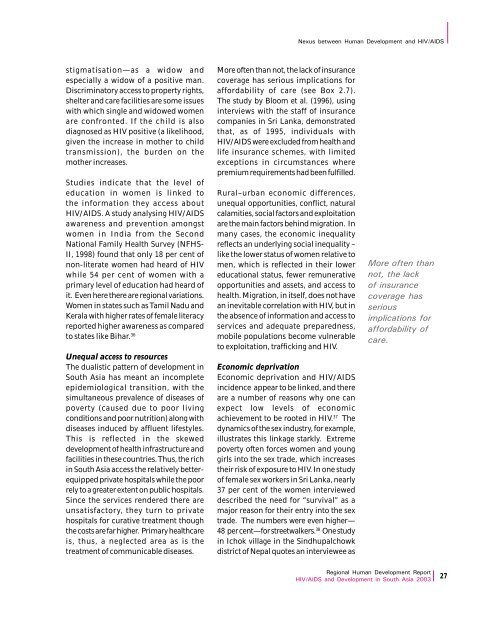Download Report - UNDP Asia-Pacific Regional Centre - United ...
Download Report - UNDP Asia-Pacific Regional Centre - United ...
Download Report - UNDP Asia-Pacific Regional Centre - United ...
You also want an ePaper? Increase the reach of your titles
YUMPU automatically turns print PDFs into web optimized ePapers that Google loves.
Nexus between Human Development and HIV/AIDSstigmatisation—as a widow andespecially a widow of a positive man.Discriminatory access to property rights,shelter and care facilities are some issueswith which single and widowed womenare confronted. If the child is alsodiagnosed as HIV positive (a likelihood,given the increase in mother to childtransmission), the burden on themother increases.Studies indicate that the level ofeducation in women is linked tothe information they access aboutHIV/AIDS. A study analysing HIV/AIDSawareness and prevention amongstwomen in India from the SecondNational Family Health Survey (NFHS-II, 1998) found that only 18 per cent ofnon-literate women had heard of HIVwhile 54 per cent of women with aprimary level of education had heard ofit. Even here there are regional variations.Women in states such as Tamil Nadu andKerala with higher rates of female literacyreported higher awareness as comparedto states like Bihar. 36Unequal access to resourcesThe dualistic pattern of development inSouth <strong>Asia</strong> has meant an incompleteepidemiological transition, with thesimultaneous prevalence of diseases ofpoverty (caused due to poor livingconditions and poor nutrition) along withdiseases induced by affluent lifestyles.This is reflected in the skeweddevelopment of health infrastructure andfacilities in these countries. Thus, the richin South <strong>Asia</strong> access the relatively betterequippedprivate hospitals while the poorrely to a greater extent on public hospitals.Since the services rendered there areunsatisfactory, they turn to privatehospitals for curative treatment thoughthe costs are far higher. Primary healthcareis, thus, a neglected area as is thetreatment of communicable diseases.More often than not, the lack of insurancecoverage has serious implications foraffordability of care (see Box 2.7).The study by Bloom et al. (1996), usinginterviews with the staff of insurancecompanies in Sri Lanka, demonstratedthat, as of 1995, individuals withHIV/AIDS were excluded from health andlife insurance schemes, with limitedexceptions in circumstances wherepremium requirements had been fulfilled.Rural–urban economic differences,unequal opportunities, conflict, naturalcalamities, social factors and exploitationare the main factors behind migration. Inmany cases, the economic inequalityreflects an underlying social inequality –like the lower status of women relative tomen, which is reflected in their lowereducational status, fewer remunerativeopportunities and assets, and access tohealth. Migration, in itself, does not havean inevitable correlation with HIV, but inthe absence of information and access toservices and adequate preparedness,mobile populations become vulnerableto exploitation, trafficking and HIV.Economic deprivationEconomic deprivation and HIV/AIDSincidence appear to be linked, and thereare a number of reasons why one canexpect low levels of economicachievement to be rooted in HIV. 37 Thedynamics of the sex industry, for example,illustrates this linkage starkly. Extremepoverty often forces women and younggirls into the sex trade, which increasestheir risk of exposure to HIV. In one studyof female sex workers in Sri Lanka, nearly37 per cent of the women intervieweddescribed the need for “survival” as amajor reason for their entry into the sextrade. The numbers were even higher—48 per cent—for streetwalkers. 38 One studyin Ichok village in the Sindhupalchowkdistrict of Nepal quotes an interviewee asMore often thannot, the lackof insurancecoverage hasseriousimplications foraffordability ofcare.<strong>Regional</strong> Human Development <strong>Report</strong>HIV/AIDS and Development in South <strong>Asia</strong> 2003 27
















